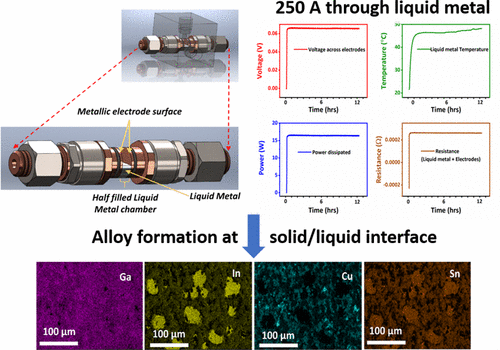当前位置:
X-MOL 学术
›
ACS Appl. Electron. Mater.
›
论文详情
Our official English website, www.x-mol.net, welcomes your
feedback! (Note: you will need to create a separate account there.)
Investigating Liquid Metal Galinstan as a High Current Carrier and Its Interaction with Collector Electrodes
ACS Applied Electronic Materials ( IF 4.3 ) Pub Date : 2020-08-10 , DOI: 10.1021/acsaelm.0c00551 Daniel K. Sarfo 1 , Richard R. Taylor 2 , Anthony P. O’Mullane 1
ACS Applied Electronic Materials ( IF 4.3 ) Pub Date : 2020-08-10 , DOI: 10.1021/acsaelm.0c00551 Daniel K. Sarfo 1 , Richard R. Taylor 2 , Anthony P. O’Mullane 1
Affiliation

|
In this work, we demonstrate the potential application of liquid metal galinstan as a means of carrying high currents between two collector electrodes. The room-temperature liquid metal was placed between two electrodes made either of stainless steel (SS) or of copper, where the electrical performance at applied currents as high as 250 A was monitored and found to be highly stable. The surface interaction between galinstan and the collector electrodes in the presence and absence of such high DC currents was also investigated. After 12 h of contact with Cu electrodes, analysis by X-ray diffraction and energy-dispersive X-ray experiments revealed the presence of Ga and Cu as well as evidence of very minor InSn phase separation from liquid galinstan to form a solid alloy. However, after the application of a DC current of 250 A for 12 h, extensive Cu–Ga alloy formation was observed in the form of CuGa2, as well as a more pronounced phase separation of the In and Sn components into islands of InSn. It was found that the slight temperature rise during electrical testing favored alloy formation but was not the origin of the phase separation of the In–Sn components. In contrast, analysis of the SS electrode after 24 h of an applied DC current of 250 A did not reveal any form of alloy formation. This work shows that the electrical performance of liquid metal galinstan is stable upon the application of high DC currents using two different contact materials even though the interaction with the contacts differs. In addition, this provides an interesting pathway that can be explored for alloy production using galinstan and Cu materials under the application of an applied current, which may have other uses apart from high-current-density carriers.
中文翻译:

研究液态金属Galinstan作为高电流载体及其与集电极的相互作用
在这项工作中,我们演示了液态金属镓在两个集电极之间承载大电流的潜在应用。将室温液态金属放置在由不锈钢(SS)或铜制成的两个电极之间,在此情况下,在施加的电流高达250 A的情况下,其电性能受到监控,并具有很高的稳定性。还研究了在存在和不存在这种高直流电流的情况下,盖林斯坦电极和集电极之间的表面相互作用。与Cu电极接触12小时后,通过X射线衍射和能量色散X射线实验分析发现,存在Ga和Cu,并且有证据表明InSn与液态gal硅的分离很小,形成固态合金。但是,施加250 A的直流电流12小时后,2以及In和Sn组分更明显的相分离成InSn岛。发现在电测试过程中温度的轻微升高有利于合金的形成,但并非In-Sn组分相分离的起源。相反,在施加250 A直流电流24小时后,对SS电极的分析未发现任何形式的合金形成。这项工作表明,即使使用两种不同的接触材料,在施加高DC电流时,液态金属Galinstan的电性能也是稳定的,即使与触点的相互作用不同。此外,这提供了一条有趣的途径,可以在施加电流的情况下探索使用镓锡林和铜材料生产合金的途径,除了高电流密度载流子以外,它还可能具有其他用途。
更新日期:2020-09-22
中文翻译:

研究液态金属Galinstan作为高电流载体及其与集电极的相互作用
在这项工作中,我们演示了液态金属镓在两个集电极之间承载大电流的潜在应用。将室温液态金属放置在由不锈钢(SS)或铜制成的两个电极之间,在此情况下,在施加的电流高达250 A的情况下,其电性能受到监控,并具有很高的稳定性。还研究了在存在和不存在这种高直流电流的情况下,盖林斯坦电极和集电极之间的表面相互作用。与Cu电极接触12小时后,通过X射线衍射和能量色散X射线实验分析发现,存在Ga和Cu,并且有证据表明InSn与液态gal硅的分离很小,形成固态合金。但是,施加250 A的直流电流12小时后,2以及In和Sn组分更明显的相分离成InSn岛。发现在电测试过程中温度的轻微升高有利于合金的形成,但并非In-Sn组分相分离的起源。相反,在施加250 A直流电流24小时后,对SS电极的分析未发现任何形式的合金形成。这项工作表明,即使使用两种不同的接触材料,在施加高DC电流时,液态金属Galinstan的电性能也是稳定的,即使与触点的相互作用不同。此外,这提供了一条有趣的途径,可以在施加电流的情况下探索使用镓锡林和铜材料生产合金的途径,除了高电流密度载流子以外,它还可能具有其他用途。











































 京公网安备 11010802027423号
京公网安备 11010802027423号